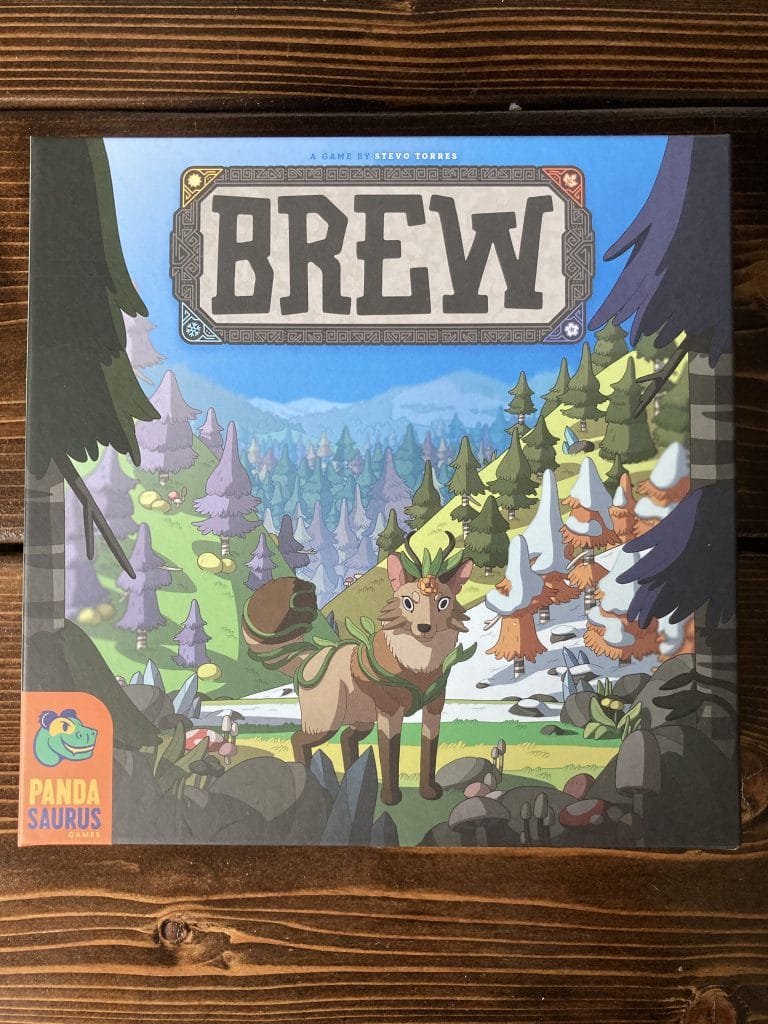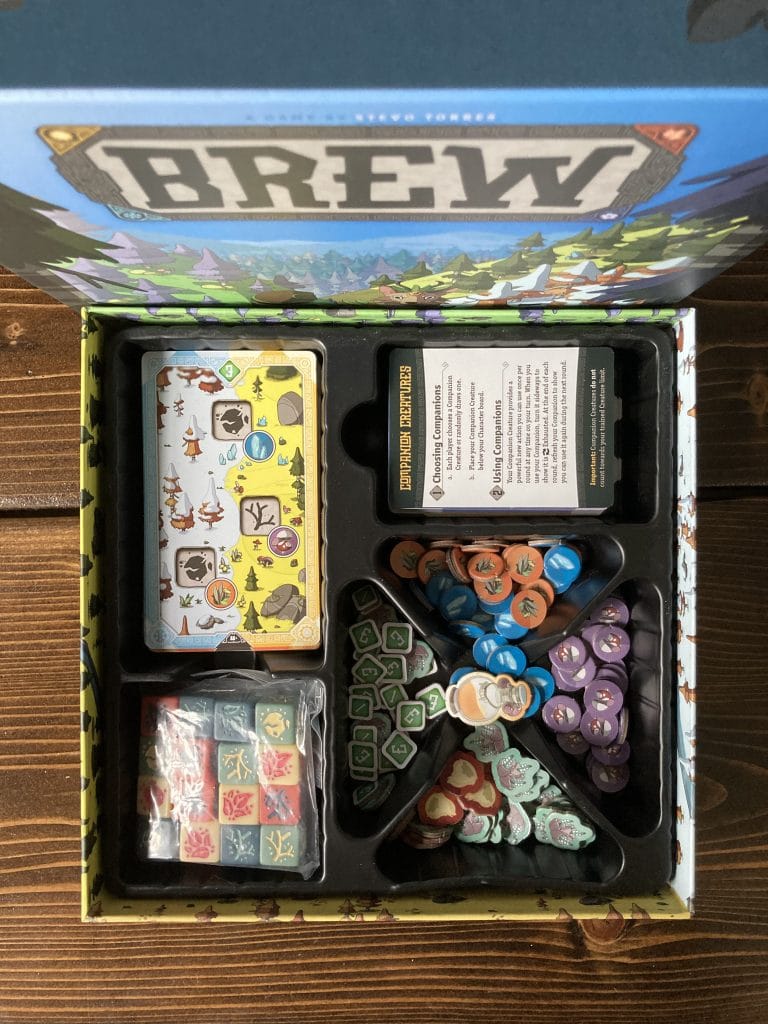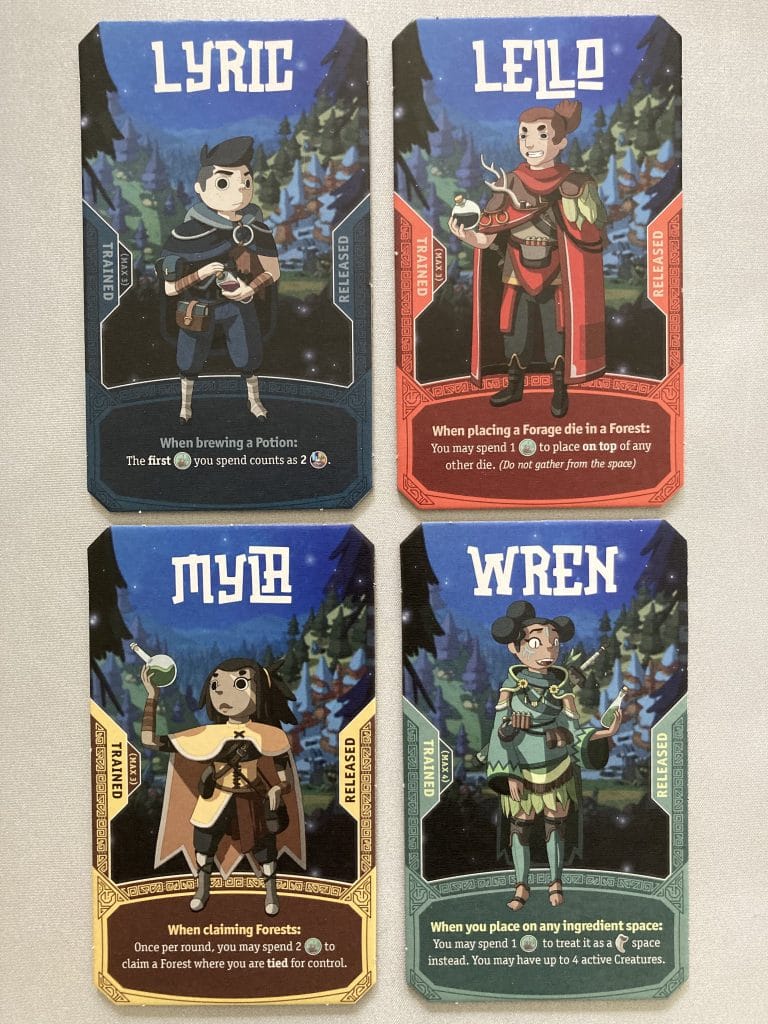One thing that surprised me about Pokemon Sun and Moon was the introduction of the Alola variants of Pokemon. This meant that you could find an Ice-type Vulpix or a Dugtrio with heads of hair that would make He-Man jealous. It was a wonderful introduction to regional variants, and made me wonder, “Why didn’t they do this sooner?”
So, when I saw all of the adorable and sometimes-zany creatures in the Brew board game, I knew it was a game that I needed to try. Fire & Ice pigeons? Fungal toads? Crystalline wolves? Yeah, I’m here for ALL of that!
Brew, designed by Stevo Torres and published by Pandasaurus Games, showcases delightful animal illustrations to offset the story that time is damaged! Players must work together to bring balance to the Force forest by controlling the elements, taming magical creatures, and brewing potions.
Let’s check it out!
Brew Gameplay
Brew is played over 4 rounds, in which players take turns performing actions to control Forests, Train creatures, brew Potions, and drink Potions. On a turn, players have the following options, and can perform them in any order:
- You must place a die from their dice pool. Forage dice must be placed on a matching Forage Symbol, and Element dice can be placed on any Forage Symbol or matching Element symbol.
- You may brew 1 Potion from the Market, paying the necessary ingredient costs.
- You may drink 1 Potion from your hand.
Placing dice is the core mechanic of Brew. It’s how you accumulate all of the ingredients needed to make potions, as well as how you can train Creatures to aid you in your quest.
Dice placement matters because whoever holds control of a Forest at the end of a round claims that Forest, and its Victory Points. However, in order to be the majority leader of a Forest, you must have more Forage dice than all other players AND you must have more Forage dice than there are Element dice in the Forest.
After all players run out of dice, the Round ends. The game board gets flipped over, turning Day to Night or Night to Day, offering new actions for players to take.
Potions offer players many different ways to manipulate the board and dice, either by scorching locations and making them inaccessible to be used, or changing dice faces and placements.
Each player can only have three trained Creatures by default. Creatures also offer up conditional effects. For example, one might grant VP if you train a Creature. Others can offer an additional space to place your Forage dice to get access to ingredients. If you exceed your cap of three Creatures, you can Release them into your claimed Forests to gain extra VP at the end of the game.
Play continues until all four rounds are completed. At this point, players add up all of their Victory Points from the following sources:
- Brewed Potions give VP based on their individual values, regardless of whether they were drunk.
- Claimed Forests give VP based on the values at the top of the card.
- Released Creatures give 3VP whereas all other creatures give 1VP.
- VP Tokens can be accumulated throughout the game through various actions.
- Any leftover ingredients score 1VP per 3 ingredients remaining.
Whoever has the highest points wins Brew!
Staking Our C.L.A.I.M. on Brew
![]() Components
Components
Pandasaurus Games continues to make a name for themselves in offering high-quality components for their games.
In Brew, I especially love the dice design for the Forage dice and the Element Dice. Both types of dice have engraved and painted designs, which is my absolutely favorite style of dice. Specifically, the Forage dice feature the icon engraved while the Element dice have the area surrounding the icon engraved. This really helps the design pop off the dice face.
You’re getting two different card sizes in Brew. The Forest cards are taller, matching the same dimensions as the Character boards. The game also comes with double-sided Player Reference cards, which ended up being a huge help when first learning the game. All of the other cards – Potions and Creatures – are standard card sizes. All of the cards are of a nice quality with a glossy finish.
Brew also comes with a veritable bounty of cardboard tokens to represent the various ingredients and Victory Point markers. Where some companies might skip on the cardboard thickness, Pandasaurus went all-in and made them the same thickness as the Character boards and game board. You’re handling these tokens a lot, between gathering ingredients and paying for Potions, so I really appreciate the quality.
One thing to note is that my copy of Brew didn’t come with any plastic baggies, which makes the ingredient storage more of a free-for-all in the plastic insert for the box. For me, this wasn’t a huge deal since I have so many little extra baggies from other board games. And, I’m a big advocate for reducing plastic use and waste, especially when it comes to the board game industry. However, Pandasaurus has noted that this was an oversight on their part and should be rectified in future printings of the game.
Each Character also has their own special power, which offers an extra dimension to help direct your strategy. If you’re just starting out, you can simply flip over the Character to keep things a little simpler and forego the Character-specific powers for the game.
![]() Luck
Luck
The strategy of Brew and be sort of overwhelming when you first start out the game. In fact, in our first game my wife said, “There’s so much to do that I don’t even know where to begin!” Between planning out ingredients needed for specific potions, balancing out the Forest control, and choosing which Creature(s) you might want to add to your stable, the options are constantly changing.
After a few rounds, however, I found that players begin to settle into a groove. Sometimes it’s about maximizing your ingredients to ensure you’ll have enough to buy the more powerful effects. Other times you want to focus on Creatures that will give you the most payoff over the course of the game. But everything always comes back to controlling the Forests.
The most important thing to note going into the game is that there is plenty of player interaction and “take-that” mechanics. In some games, such mechanics may be far and few between, making it jarring when they actually happen. With Brew, you need to expect that other players will mess with your dice, prevent you from placing dice in specific locations, and scorching Forests before you can fully enact your plan.
Once you come to grips with the fact that the game features player interaction like this, and that such interaction isn’t PERSONAL, you’re bound to enjoy it that much more.
I also really like that you can hardly brew any Potions and win the game, or you can hardly train any Creatures and win the game. There is no single true route to victory, which means that you can try something different each time that you play. And, something that worked last game might not work out the next.
![]() Aesthetics
Aesthetics
Without gushing about the dice more than I already have, the overall look of Brew is exceptional. Jake Morrison and Andrew Thompson have really brought forth a sort of whimsical, fun, cute aesthetic that invokes a lot of nostalgia for me. The isometric view and style remind me of playing Earthbound on SNES, which is one of my top games of all time.
And then, of course, you have the different iterations of the creatures depending on the seasons they’re associated with. It just makes for an endearing sort of feeling, with nods to Pokemon as mentioned above.
The iconography is super easy to become comfortable with. Gray squares indicate places where dice can be placed. Dice restrictions are either in the boxes or in the corners. Ingredient gains or Creature trainings are shown in the lower right of the dice boxes. I sort of wish the Fire Element icon on the main game board was in the upper right/left of its respective space, just to be consistent with the rest of the icons.
There’s enough differentiation between the shape and color in the components that makes the game very accessible to everyone. The only thing that might be a potential issue is finding the season iconography on the Forecast cards. It might be a little faint compared to some of the other icons, but once you’ve located it it shouldn’t take long to recognize it more easily. Plus, the Creature piles are sorted by season and their placement is static, which also helps.


![]() Interest
Interest
Brew is made for people who really like a lot of player interaction, and who won’t get upset when they are targeted by the other players. The area control elements drive strategy, especially since your own Element dice can hamper your control of a location if you’re not careful.
If you like Pandasaurus Games’ other recent title, Umbra Via, you’ll probably also be drawn to Brew, albeit in a slightly different way. Instead of blind bidding, the areas are fully in play during each round. Do you use a Forage dice to train a Creature, knowing that you’re willingly giving up a dice that could help you take control of a Forest? You’re constantly facing these sorts of decisions during the game.
Worker placement, resource management, and area control are the main mechanics of the game, so if any of those are your jam then you’ll probably like Brew. For example, if you like Skora by Inside the Box Games, you’ll appreciate the area control elements. If you’re a fan of Stonemaier Games’ Viticulture, you will like how worker placement restrictions allow you to indirectly impact other players’ decisions.
I especially like Brew in the sense that I have to wait and see what dice I roll before I can plan out my strategy for a given round. It’s the epitome of making the most of what you have, and if that’s a phrase that appeals to you, then I highly recommend playing at least a couple games of Brew.
![]() Mood
Mood
Because of all the player interaction and the limited spaces to place your dice, Brew gives off a certain tenseness that is hard to describe. You’re hoping that a spot will still be open the next time you take a turn. You’re keeping your fingers crossed that not reserving a specific Potion won’t come back to bite you later on.
You also feel appreciative of the work that some of your Creatures might be doing over the course of the game. For example, if you get a Creature early on that allows you to exchange excess ingredients for Victory Points, you can accumulate a sizeable pile of VP tokens by the end of round 4. I would know; I’ve lost to such a strategy.
Overall, the aspects of the game are difficult to connect together in a way that makes sense with the theme. I’m not really sure how brewing Potions and training magical Creatures is going to help restore the sacred timeline. But, then again, do I really have to know the finer details? Let’s just write it off as MAGIC.
You will certainly get frustrated, and you’ll also be the source of others’ frustration. That comes with the territory in games with such high player interaction. However, I will say that on turns when you complete all of the actions, you feel like you’re on top of the world. Or if you can sequence your turn in a way that lets you buy a potion, change a dice face through that Potion, then snag the final spot of a Forest to give you control…that always feels great!
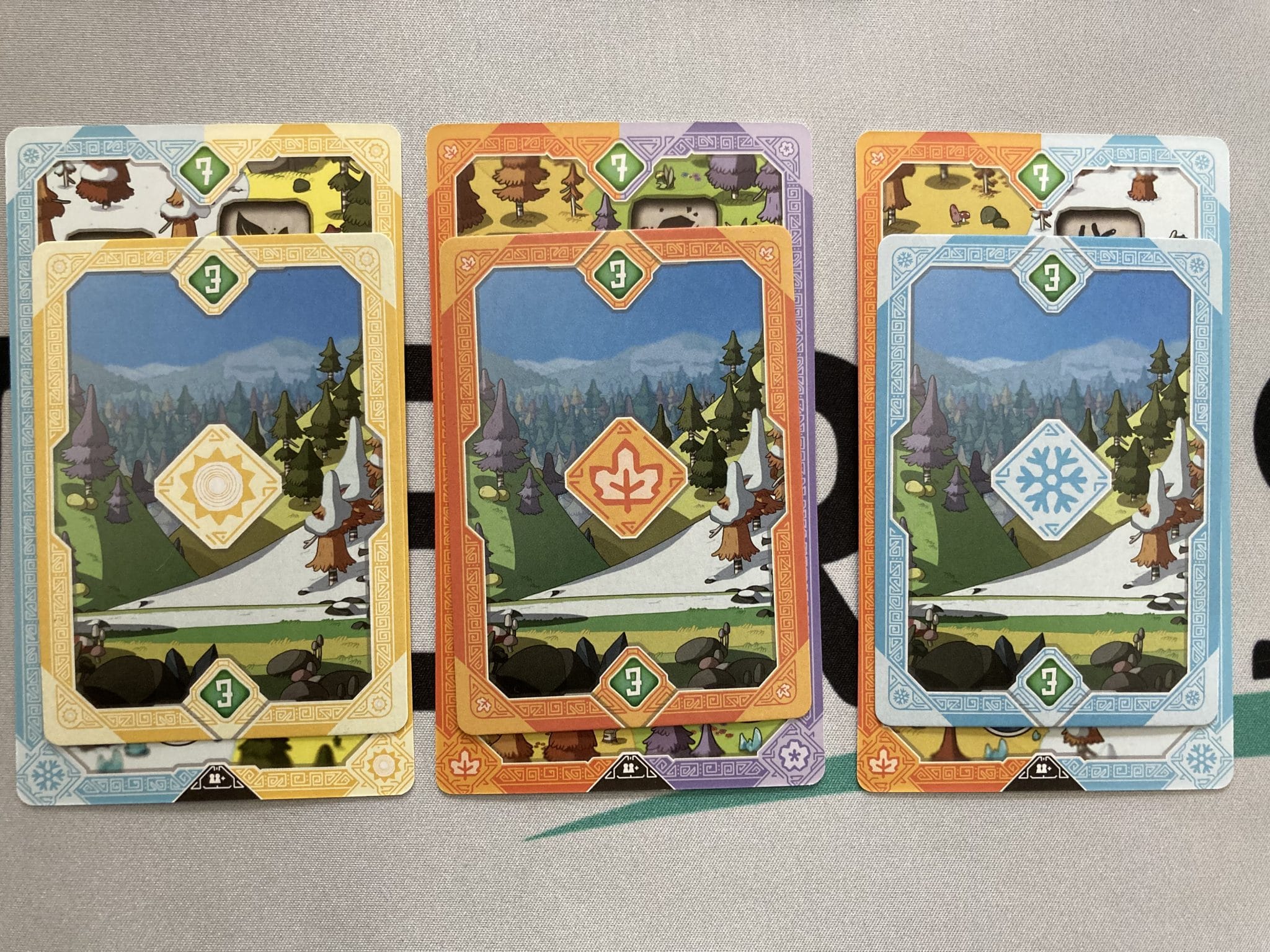
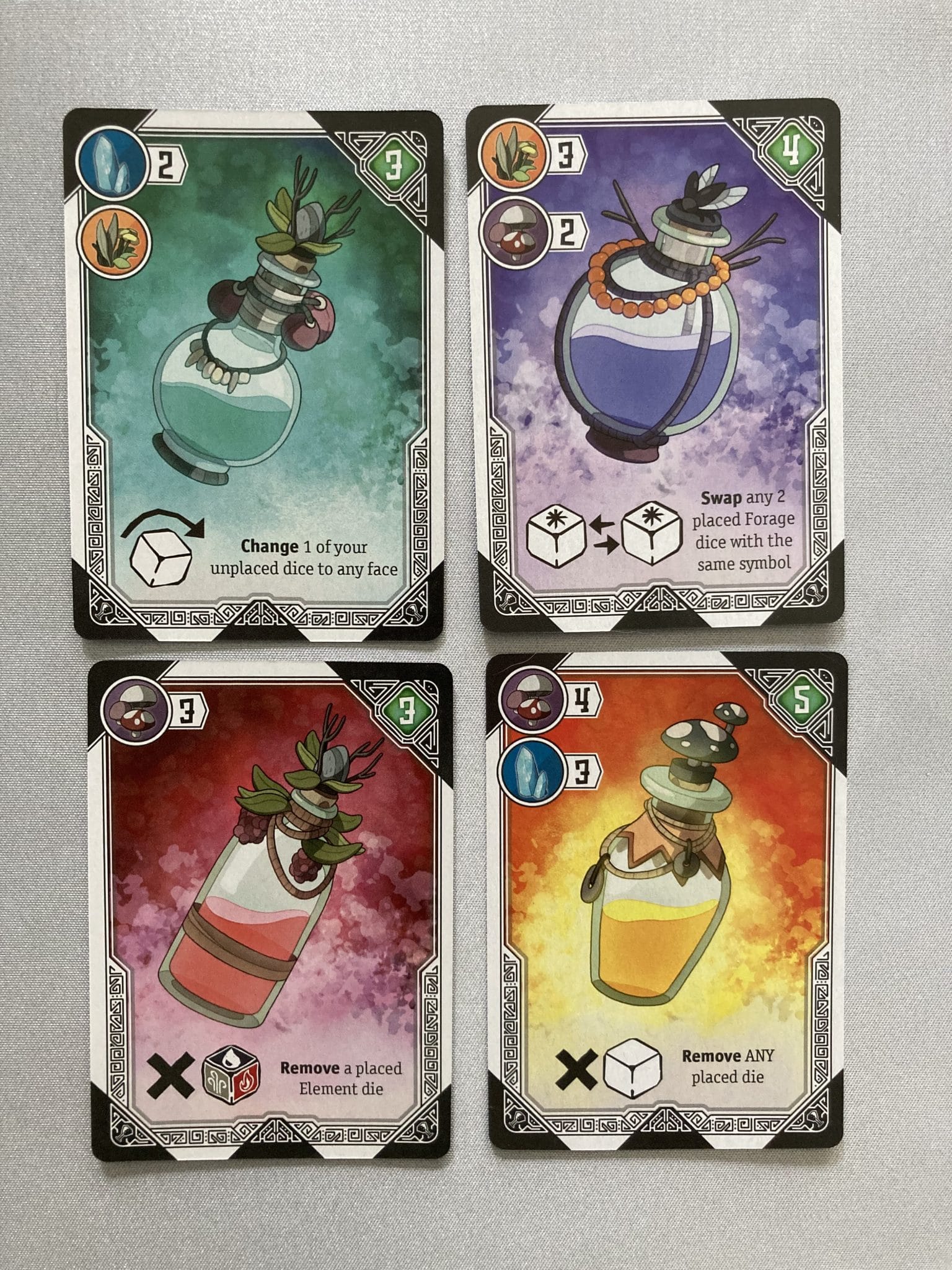

Brew: It’s Brew-tiful!
Brew is a game that I had a lot of fun with, and will continue playing for a long while. Even if it isn’t as thematically-connected to the mechanics as I’d usually prefer, the presentation and aesthetics easily allow me to look past that. I really enjoyed the tight battles over the Forests, and being able to manipulate my own dice and the dice of my opponents.
Games like Brew where you get to stack up a pile of resources, perform mini combos, and get to train so many adorable Creatures make this next statement a no-brainer: Nerds on Earth is thrilled to award a Seal of Awesomeness award to Brew! A dynamic strategy-filled game wrapped up in a gorgeous presentation, Brew is a tasteful sampler of a variety of game mechanics.
In fact, I’d go so far as to say that Brew is a game for all seasons!
You can pick up a copy of Brew through Pandasaurus Games directly, or look for it on the shelves of your Friendly Local Game Store (FLGS)!
Disclosure: Pandasaurus Games provided Nerds on Earth with a copy of Brew in exchange for an honest review.


